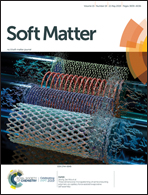Particle entrainment in dead-end pores by diffusiophoresis†
Abstract
The transport of particulate matter to and from dead-end pores is difficult to achieve due to confinement effects. Diffusiophoresis is a phenomenon that results in the controlled motion of colloids along solute concentration gradients. Thus, by establishing an electrolyte concentration gradient within dead-end pores, it is possible to induce the flow of particles into and out of the pores via diffusiophoresis, as has been demonstrated recently. In this paper, we explain the pore-scale mechanism by which individual colloids are entrained in dead-end pores by diffusiophoresis. We flow particles past a series of dead-end pores in the presence of a solute concentration gradient. Our results reveal that particles execute pore-to-pore hops before ultimately being captured. We categorize an event as particle capture when the particle's trajectory terminates within the dead-end pore. Experiments and numerical simulations demonstrate that particle capture only occurs when flowing particles are positioned sufficiently close to the pore entry. Outside this capture region, the particles have insufficient diffusiophoretic velocities to induce capture and their dynamics are largely dominated by their free-stream advective velocities. We observe that the particles move closer to the device wall as they hop, thereby reducing the effect of flow advection and increasing that of diffusiophoresis. These results enhance our understanding of suspension dynamics in a driven system and have implications for the development, design, and optimization of diffusiophoretic platforms for drug delivery, cosmetics, and material recovery.



 Please wait while we load your content...
Please wait while we load your content...